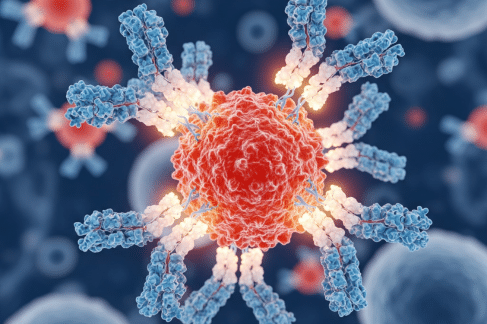Eosinophils are granulocytes, a subgroup of white blood cells known for the tiny granules inside them. These granules contain proteins and enzymes that help the body fight infections and respond to allergens.
They are produced in the bone marrow and then released into the bloodstream. After a short time, they move into tissues, such as the lungs, stomach, skin, and intestines.
A small amount of eosinophils is normal in the body. Excess eosinophils release toxic proteins that irritate tissues. This leads to chronic inflammation, tissue injury, and organ damage. This condition is known as eosinophilic disorders. It can also lead to various diseases, including:
- Asthma
- Allergic rhinitis
- Eczema
- Parasitic infections
- Eosinophilic esophagitis (EoE)
- Hypereosinophilic syndrome (HES)
- Autoimmune diseases
- Eosinophilic Gastrointestinal Disorders (EGIDs)
- Eosinophilic Granulomatosis with Polyangiitis (EGPA)
Since eosinophilic disorders can affect any organ, such as the lungs, skin, digestive tract, heart, and blood vessels, it is crucial to detect and treat these disorders at an early stage.
Traditionally, corticosteroids and immunosuppressive drugs were used. However, they have severe side effects. However, nowadays, researchers rely on monoclonal antibody drugs to design highly targeted therapies for eosinophilic disorders.
What are Monoclonal Antibody Drugs?
Monoclonal antibodies are a homogeneous mixture of identical antibody molecules produced from a single clone of B-cells. They are designed to recognize and bind to the same epitopes of an antigen.
They are known for their high specificity and precision in detection. They are widely used to detect biomarkers related to various diseases, including eosinophilic disorders.
For instance, EMR1 (Eosinophil Marker 1) is a surface protein that is specifically expressed on human eosinophils. So, it acts as a biomarker that aids in eosinophil studies.
Researchers use the EMR1 monoclonal antibody to accurately identify and study eosinophils in both healthy and diseased tissues. This further helps them examine eosinophil activity and study the underlying mechanisms of eosinophilic disorders.
Role of Monoclonal Antibodies in Eosinophilic Disorder Research
Identify Eosinophil-Specific Biomarkers
Monoclonal antibodies help scientists find biomarkers that are only present on eosinophils.
Biomarkers are special proteins or molecules that act like “ID tags.” They help researchers understand how many eosinophils are present and how active they are in the body.
For example, IL-5 receptor alpha (IL-5Rα) is a protein found on eosinophils. Researchers use monoclonal antibodies to target this protein and study how eosinophils grow and survive.
This helps them understand which proteins play the biggest role in eosinophilic diseases. Scientists can use these studies to develop new diagnostic tools and better treatment targets.
Develop Targeted Therapies
Monoclonal antibodies are used to create therapies that target eosinophils directly.
Traditional drugs like steroids affect the entire immune system, which can cause serious side effects. But monoclonal antibody drugs act only on specific proteins related to eosinophils.
For example, some therapies block IL-5, a cytokine that helps eosinophils grow. When IL-5 is blocked, eosinophil levels drop. This improves symptoms in conditions like asthma and hypereosinophilic syndrome.
These targeted therapies are more precise. They reduce inflammation without harming healthy cells. This makes them safer and more effective for long-term use.
Explore Eosinophil Functions in Disease Mechanisms
Scientists use monoclonal antibodies to study how eosinophils behave in the body.
They help track where eosinophils move, how they react to infections, and how they trigger inflammation.
Since mAbs can block or attach to certain proteins, this allows researchers to observe what happens when eosinophils are activated or suppressed. This further helps them understand how eosinophils contribute to different diseases—such as asthma, EGPA, or EoE.
Moreover, these studies reveal which pathways are harmful and which ones protect the body. This helps develop new treatments and medicines.
Improve Diagnostic Accuracy
Diagnosing eosinophilic disorders can be difficult because symptoms often look similar to other conditions.
Monoclonal antibodies make diagnosis clearer and faster. They bind to eosinophil markers and highlight them in tissue samples or blood tests. This helps doctors see eosinophils under the microscope more easily. It also allows them to measure eosinophil levels with greater accuracy.
With precise detection, doctors can confirm the diagnosis earlier. This leads to quicker treatment and prevents damage to organs.
Reduce Reliance on Steroids
Steroids were once the only option to control inflammation caused by eosinophils.
However, long-term use can cause weight gain, bone loss, infections, high blood pressure, and mood changes.
However, monoclonal antibody drugs offer a safer alternative. They lower eosinophil counts without suppressing the entire immune system. They work in a more controlled way and have fewer side effects.
So, patients with chronic eosinophilic disorders can use monoclonal antibody treatments long-term. This helps them manage their symptoms effectively while avoiding the health risks of steroid overuse.
The Bottom Line
Monoclonal antibody drugs have changed the way eosinophilic disorders are studied and treated.
They help researchers identify important biomarkers, understand disease mechanisms, and create targeted therapies that are safer and more effective. With their high precision, monoclonal antibodies allow accurate diagnosis and reduce the need for harmful steroid treatments.
However, using the high-quality mAbs for research is crucial. Otherwise, it can compromise the overall results.
